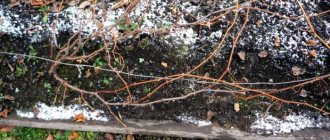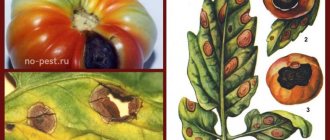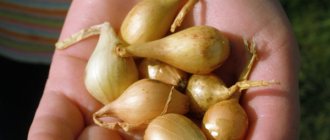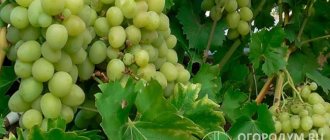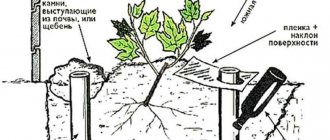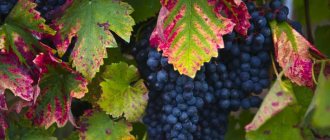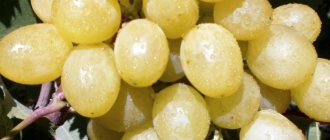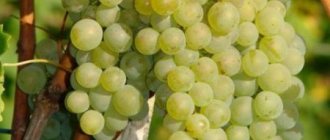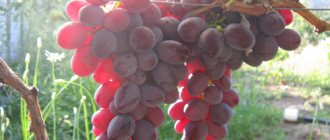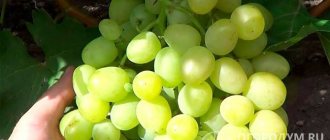Fruits and berries » Grapes
0
928
Article rating
Kira Stoletova
Grapes are a heat-loving crop. It is grown mainly in the southern regions. But winegrowers in the Moscow region can also grow berries on their plots. At the same time, it is important to choose suitable varieties and cover the grapes for the winter in the Moscow region. Simple rules for wintering a crop guarantee flowering in the spring and further fruiting.
Ways to cover grapes for the winter in the Moscow region
Varieties for temperate climates
Crop varieties should be selected based on the climate of the region. The types of berries should be:
- super early or early;
- winter-hardy and disease-resistant;
- self-pollinating;
- suitable for open ground.
The location where the crop is planted is also considered an important factor. It shouldn't be windy. When choosing non-covering (that is, those that do not protect in winter), grape varieties, remember that in winter without snow, even such types of crops can die. The roots of the bush will freeze, and the plant will not bloom in the spring. The maximum snowless temperature that the bush can withstand is -12°C.
If there is protection in the form of snow, the resistance increases to -50°C. This is the reason why, in the absence of a layer of snow, even uncovered crops are recommended to be covered. There are many methods of protection: from simple and cheap to complex and expensive.
Choosing materials for shelter
The easiest way to protect grapes is to use snow or soil. If soil will be used, it is necessary to make grooves for the vines, which are lined with dry coniferous branches, then the vines are laid. Everything is covered with a layer of earth. Depending on climatic conditions and plant variety, the thickness of this layer is approximately 20 centimeters. This method has a significant drawback - the frost resistance of the vine will decrease every year, and soon it will require more serious shelter.
The advantages of covering the vine with snow include the fact that the vine will definitely be warm. But the weather can bring an unpleasant surprise in the form of a lack of snowfall. Then it is correct to prepare special shields that will help keep the existing snow on the site; you need to add snow regularly, which is very troublesome.
It is better to think in advance about ways to insulate the grapevine in winter in order to protect the plant from bad weather at the right time. The most popular are:
- Agrofibre or film. When using the film, it is necessary to place additional coniferous branches under and above the vine to improve the thermal insulation properties. When using plastic film, you need to constantly monitor the condition of the grapes and weather conditions. On sunny and warm days, polyethylene will create a greenhouse effect and the plant will begin to rot, which is unacceptable.
- Wooden shields. They are installed on different sides of the shoots laid on the ground. A kind of house is formed. The inside of such a house can be lined with roofing felt, this will protect the young shoots from excess moisture. The method is suitable for small areas. In large vineyards, this method is impractical to use, since it requires large material and physical costs.
- Available materials. Along with the ground, you can use any available materials for shelter. These could be old metal buckets, slate sheets, plastic containers. Burlap will do; you can quickly find such materials in the garden. The main thing is to avoid excessive loads on the bushes, they can damage the vine.
Procedure time
In the Moscow region, grapes are covered for the winter at a night temperature of -2°C. Covering the crop too early or late leads to:
- condensation formation and root rotting;
- death of shoots due to lack of nutrients;
- infection with fungi or infections in an excessively hot and humid environment.
All these factors do not contribute to the development of the bush and a good quality harvest, so they cover the berries not in winter or late autumn, but at the first permanent frost. To cover the plants productively, healthy shoots are selected, and the crop is cared for during the fruiting season. So she tolerates winter better.
When to cover grapes?
Severe frosts, which are typical for most of Russia, can destroy not only annual seedlings, but also adult bushes. Without shelter, grapes can tolerate frost down to -15 degrees. A further drop in temperature leads to the death of grape eyes. First of all, annual seedlings are susceptible to this. To prevent such an unfortunate development of events, the gardener must take care of shelter for the plant with the onset of the first cold weather. But shelter alone is not enough; this event still needs to be carried out correctly.
The root system of grapes is very sensitive to low temperatures
Attention! The aboveground parts of the grapes are able to survive low temperatures, but the root system of the plant cannot boast of such frost resistance. Even a slight frost around -5 degrees can damage the fibrous part of the root system, which will ultimately lead to the death of the grapes. If the above-ground part can still be restored in case of frostbite, then in the second case this is impossible.
Of course, you first need to know the temperature regime of the region. If in your area frosts never exceed -16 degrees, then there is no need to worry too much. Frost-resistant varieties can survive harsher frosts. If it is almost impossible to predict the temperature regime of the region, then the best thing to do is to protect the plant from freezing and cover all the grape bushes.
Preparing the plant for wintering
Preparation for winter is carried out as follows:
- Wait for the plant to shed its leaves.
- The bush is pruned and the vine is pressed to the ground with staples. It should not touch the ground.
- Wooden sawdust or blocks are placed under it.
To prevent pests and infections, the vine is treated with lime or copper sulfate. Do not place polyethylene or fallen leaves under the vine: this leads to condensation and rotting.
Bushes with mildew should not be left to overwinter. They are cut, uprooted and destroyed.
They also choose material to cover the crop. You can cover grapes for the winter in the Moscow region with several materials: earth, pine branches, slate, roofing felt, agrofibre. The material should be taken care of in advance. If necessary, it is dried and cleaned of wet soil and mold.
The age of the vine is also important when choosing a method. Young bushes are covered with a “house”, trying not to bend or break. They are protected in several ways at the same time. More mature and stronger plants can be bent to the ground or covered using one of the available methods.
How to cover grapes for the winter in the Moscow region
Many gardeners do not insulate mature shrubs of zoned varieties before wintering. The vine can withstand temperatures down to -29 degrees. Most often, young grapes and varieties that are afraid of frost are sheltered for the winter in the Moscow region. There are several methods and materials for insulating a vineyard. We will introduce you to the simplest and most reliable ones.
Click on the link to learn about covering young grapes 1 year of planting.
Before sheltering, the vines of one bush are tied together, bent and pinned to the ground. But you need to make sure that they do not touch the soil, for which purpose they put supports under the shoots. These can be thick tree branches, wooden blocks, foam plastic. If the vine comes into contact with the ground, it may begin to mold.
Agrofibre
If you are interested in how to quickly and reliably cover grapes in the Moscow region for the winter, read the tips and watch the video.
The easiest way is to cover it with non-woven material, lutrasil or agrospan. It is recommended to take the material 60 mm thick and fold it in two layers. There will be an air gap between the layers. As a result, two layers of material and a layer of air will reliably protect the grapevine from freezing.
But you should not throw material on bent shoots. It is recommended to install arcs above them. You can install supports along the edges of the vineyard and stretch wire between them. In this case, the agrofibre will not lie on the vine, but on arcs or wire. In winter there can be a lot of snow. It becomes especially difficult during thaws. To prevent it from crushing the shoots, it is better to make a frame over the grapes to cover them with non-woven material.
For reliability, the shoots are insulated from above with dry leaves or straw, and then with lutrasil.
You will be interested to know: Sheltering young grapes of 1 year for the winter: when, how and with what to cover the seedling
The agrofibre needs to be secured on the sides. You can use bricks, boards, plastic bottles with water or other heavy means at hand. The main thing is that they hold the material well.
VIDEO: HOW TO COVER GRAPES WITH AGRIFiber
Lapnik
Coniferous tree branches will do an excellent job of protecting grapes from frost. They are a breathable material, so you don’t have to worry about ventilating the vine.
The branches are laid not in one, but in 2-3 layers. They are secured on top with slate or boards, otherwise a strong wind will blow the spruce branches across the site.
Covering grapes with soil
Earthen shelter for vines is an excellent way to protect grapes from frost in the Moscow region. The soil should have a layer of about 20 cm. But they do not add it immediately, but gradually:
- during the first frost, the bent vine is covered with a 10 cm layer of earth;
- after a month, cover with another 10 cm layer of soil.
For reliability, you can install wooden panels or boards over the vineyard in the form of a house and cover them with roofing felt. Under such shelter, plants will not be afraid of any frost or thaw. If you insulate only with soil, it will get wet during warming periods and freeze in cold weather. Ruberoid will protect it from snow.
It is important! To cover the grapes with soil, only dry soil should be used. To do this, it is prepared in advance and stored in bags.
Other materials for covering vines
Sometimes gardeners insulate the vineyard with film or roofing felt. Experienced winegrowers do not recommend using such materials, as they do not allow air to pass through. Condensation will accumulate on the film during a thaw, the vine will get wet, and during frosts it will freeze.
You can use a special polymer film and stretch it over the arches or frame. Roofing felt is also stretched over the vineyard. In the spring, when it warms up, it will need to be opened slightly, otherwise the vine will dry out.
You may be interested to know: How to feed raspberries in early spring for a good harvest
Earth cover technology
Straw retains heat well
This method is complicated because it requires thorough preparation. First, the vines are laid out in dug grooves and secured there with wooden blocks or staples. For shelter, dry, loose soil is dug up outside the vineyard.
The vine is sprinkled with straw or peat. For the Moscow region it is better to use a three-layer shelter:
- 5-15 cm of soil;
- 5-10 cm organics;
- 20-25 cm of loose dry soil.
Additionally, the grapes are covered with snow, as it has a good ability to protect crops from freezing.
How to prepare a vineyard for shelter
Before covering the grapes on the eve of winter, gardeners carry out preliminary preparation of the plants. In the Moscow region they proceed as follows:
- During the fall, feed the plants with fertilizers containing potassium;
- seedlings in front of the shelter are covered with earth so that they are as deep as possible (this is the only way to protect young shoots from freezing);
- one-year-old vines are pruned, leaving one shoot with 3-4 eyes, and if the grapes are 2 years old, two shoots are left after pruning;
- after pruning, the vines are removed from the trellises, bent and fixed on wooden planks using metal brackets;
- when covering the grapes, make sure that the shoots do not come into contact with the ground;
- they take care to provide the sheltered vineyard with a reliable outer cover of snow.
Roofing felt or film coating
This method requires minor construction skills. The structure is created like this:
- Metal arcs are installed, a film is stretched over them or roofing felt is placed.
- The vine is covered with straw or pine branches.
- For durability, the film is secured with bricks.
The disadvantage of this method is that the materials do not allow air to pass through. From time to time the culture is ventilated, which creates additional difficulties. Unlike roofing felt, slate allows air to pass through and protects against precipitation.
Hay, sawdust and the same pine needles are laid inside. But slate is an expensive material, and not every winegrower can afford it.
Grapes in a greenhouse - how to close
Growing grapes in a greenhouse is justified not only for regions with extreme climates. The North-West and Belarus are not the best climatic zones for harvesting outdoors. The grape bush is so sensitive to excess moisture that even in the south they try to plant it under light shelter from the rain.
Theoretically, there is no point in being particularly zealous in covering the grapes with protected soil. Experience shows that in winter any surprises are possible. It is better to take precautions and cover the grapes for winter. Perform the standard sequence of operations:
- The vines are processed, pruned and tied into bunches.
- The grape trunk circle is covered with a layer of leaves, sawdust, spruce branches; bent to the ground and pinned with arcs.
- PE film is placed over the arcs.
- The edges of the film are pressed with bricks or boards.
Use of agrofibre
This method is the most optimal of those listed. Agrofibre is a special polypropylene material created to insulate berries, protect them from moisture and not block the air. The fabric is fixed above the vine with bricks. It allows air to pass through and retains snow, which gives the bush additional protection.
If the bush is mature, it is not necessary to trim it: it is wrapped in several layers of polypropylene and secured with twine. Plants are covered with leaves if they are healthy and dry.
Timing of plant opening after wintering
The grapes must be opened in the first week of April. Although if the weather is still frosty, the removal of protection is postponed at least until 0℃ on average per day.
If the vineyard is nearby, it will be useful to prepare smoke piles and checkers to protect the vines from frost. They are placed on the sides of the vineyard and set on fire when frost hits. One pile is valid for 100 sq. m.
How to make a smoke pile:
- Straw, dry leaves, shavings are needed inside for combustion.
- Leaves, tops and fuel oil for smoking are laid on top. Everything is covered with a layer of earth.
- Set the structure on fire from below.
The recommended heap size is 1 x 1.5 m. If it is not possible to protect the plants in this way, they are sprayed with plain water. It sets into an ice crust and protects the bush from temperature changes.
